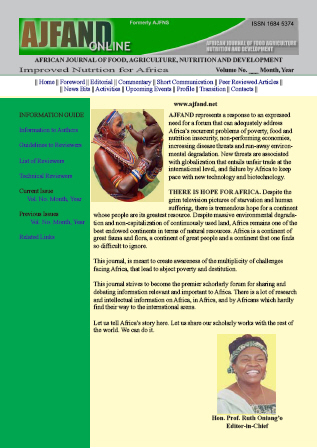
|
African Journal of Food, Agriculture, Nutrition and Development
Rural Outreach Program
ISSN: 1684-5358
EISSN: 1684-5358
Vol. 8, No. 2, 2008, pp. 118-132
|
 Bioline Code: nd08013
Bioline Code: nd08013
Full paper language: English
Document type: Research Article
Document available free of charge
|
|
|
African Journal of Food, Agriculture, Nutrition and Development, Vol. 8, No. 2, 2008, pp. 118-132
| en |
Fatty Acids In The Nut Of The Turkana Doum Palm ( Hyphaene coriacea  ) )
Lokuruka, Michael N. I.
Abstract
Although Uganda is well endowed with adequate food supplies, more than one third of the children under the age of five are malnourished and 60% of all deaths of children under five years of age are directly or indirectly attributable to malnutrition. The causes of this public health problem in Uganda are complex and multidisciplinary, but poor quality and quantity of foods given to children play a major role. In this study, we conducted a rat feeding trial experiment in order to explore the potential of a banana-soy based diet optimally incorporated with sesame as a complementary diet to support growth of children. The study applied sensory evaluation and rat feeding trial experiments to investigate the optimum level of sesame incorporation in an earlier formulated bananasoy diet and as well explore the nutritional value of the final diet. Crude protein, ash and energy contents of the formulations were determined using AOAC methods. Data were analyzed using GenStat 5 Release 3.2. Nutrient and energy composition was compared using ANOVA and PER was compared using t-test. Results showed that a mixture of 67% banana, 16.5% soybean and 16.5% sesame flours produced a blend whose proximate analysis, PER and sensory evaluation studies had satisfactory nutritional quality, quantity and optimum organoleptic attributes. There was a high nutritional quality attained when soy and sesame flours were mixed in equal proportions. Therefore optimum incorporation of soybean and sesame in banana based complementary diets not only greatly enhances nutrient density and quality of these diets but also their organoleptic attributes. Feeding children these diets could break the cycle of childhood malnutrition through reduced feeding of starchy gruels that have low energy and protein contents or with undesirable sensory properties. The mixture is also easy to prepare at community level and may be adequate for catch up growth among children recovering from malnutrition.
Keywords
Hyphaene coriacea, Turkana, fatty acids
|
| |
© Copyright 2008 -Rural Outreach Program
Alternative site location: http://www.ajfand.net/
|
|
